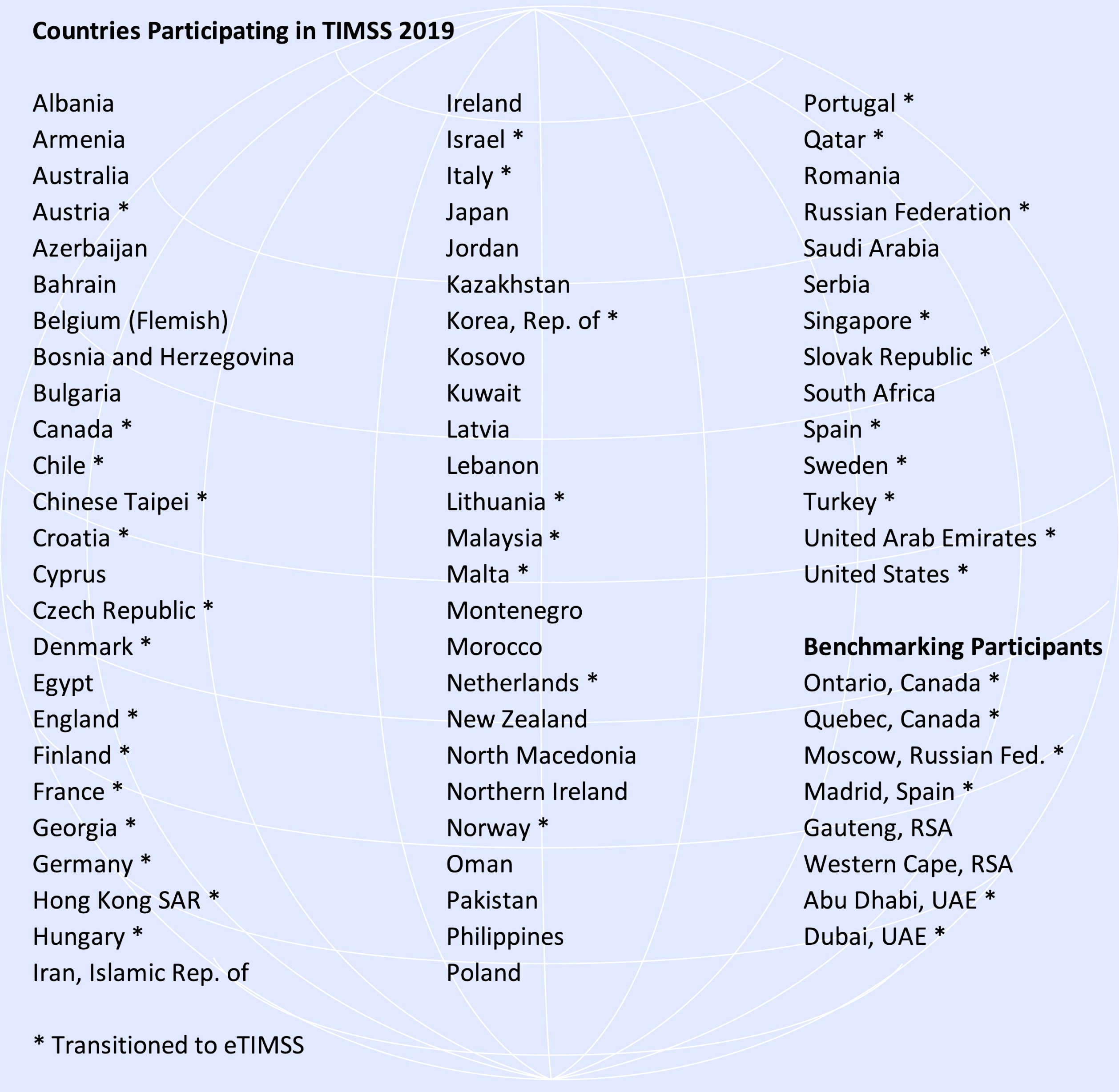IEA’s TIMSS 2019 is the seventh assessment cycle of TIMSS, the Trends in International Mathematics and Science Study. TIMSS 2019 was conducted at the fourth and eighth grades in 64 countries and 8 benchmarking systems. Inaugurated in 1995, TIMSS has been conducted every four years since, providing 24 years of trends in mathematics and science achievement.
+ Read MoreIn 2019, TIMSS began the transition to computer-based assessment by introducing a computerized version—eTIMSS. Half the participating countries in 2019 chose to administer the new eTIMSS version, while the other half continued to administer the paper-based version.
+ Read MoreAs shown below, 64 countries participated in TIMSS 2019, including some distinct education systems within countries that have always participated separately throughout IEA’s long history (e.g., the Dutch-speaking part of Belgium and Hong Kong Special Administrative Region (SAR) of the People’s Republic of China). In addition, TIMSS 2019 had 8 benchmarking participants, (e.g., regional entities, such as provinces and municipalities).
+ Read MoreThe TIMSS 2019 mathematics and science assessments are based on comprehensive frameworks developed collaboratively with the participating countries. The TIMSS 2019 Mathematics Framework and the TIMSS 2019 Science Framework are each organized around two dimensions: a content dimension specifying the content to be assessed and a cognitive dimension specifying the thinking processes to be assessed.
+ Read MoreThe TIMSS 2019 International Mathematics and Science Results report presents TIMSS 2019 average mathematics and science scale scores and score distributions at the fourth and eighth grades for each participating country and benchmarking system. Scaling the TIMSS 2019 achievement data proceeded in two phases: calibrating the paperTIMSS and bridge data on the TIMSS 2019 achievement scales, and linking the eTIMSS data to these scales via the bridge data. This process enabled the eTIMSS and paperTIMSS achievement results to be reported on the same achievement scale in each grade and subject.
+ Read MoreThe goal of TIMSS is to provide the best policy-relevant information to help improve mathematics and science teaching and learning. TIMSS 2019 included student, teacher, and school questionnaires and the Early Learning Survey (also called the “home questionnaire”) completed by students’ parents or caregivers. Many of the questionnaire items were developed and analyzed as item response theory (IRT) scales to provide robust indicators of important aspects of schooling (e.g., school safety, students’ attitudes toward learning mathematics and science, the impact of an early start). Together, the questionnaire results provide a wealth of information about the home, school, and classroom contexts in which students learn mathematics and science. The results from the questionnaires are reported in the Home & School Contexts and Classroom Contexts parts of this report.
+ Read MoreTIMSS assesses students in participating countries in their fourth year of formal schooling, provided the mean age at the time of testing is at least 9.5 years, and in their eighth year of formal schooling, provided the mean age at the time of testing is 13.5 years. Because education systems vary in structure and in policies and practices with regard to age of starting school and promotion and retention, there are differences across countries in how the target grades are labeled and in the average age of students. Moreover, some countries choose to administer TIMSS to a different grade than the fourth or eighth years of formal schooling. Norway chose to assess fifth and ninth grade students to obtain better comparisons with Sweden and Finland. South Africa and its benchmarking systems assessed fifth and ninth grade students to better match their curricula and to maintain trend measurement. Turkey also chose to assess students in the fifth grade.
+ Read MoreTIMSS 2019 made every effort to attend to the quality and comparability of the data through careful planning and documentation, cooperation among participating countries, standardized procedures, and rigorous attention to quality control throughout. The assessments were administered to nationally representative and well-documented probability samples of students in each country. Staff from Statistics Canada and IEA Hamburg worked with National Research Coordinators on all phases of sampling activities to ensure compliance with sampling and participation requirements, with the few exceptions from compliance annotated in the data exhibits.
+ Read MoreThe TIMSS 2019 International Mathematics and Science Results report presents results from TIMSS 2019 in 14 chapters. Report readers can view the TIMSS 2019 results using the navigation buttons across the top of the report website, or access each chapter using the side menu. Exhibits and report text can be downloaded and printed from the Download Center in the side menu and on pages throughout the website.
+ Read More
